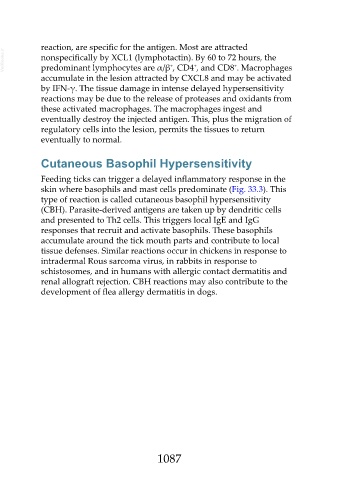Page 1087 - Veterinary Immunology, 10th Edition
P. 1087
reaction, are specific for the antigen. Most are attracted
VetBooks.ir nonspecifically by XCL1 (lymphotactin). By 60 to 72 hours, the
+
+
+
predominant lymphocytes are α/β , CD4 , and CD8 . Macrophages
accumulate in the lesion attracted by CXCL8 and may be activated
by IFN-γ. The tissue damage in intense delayed hypersensitivity
reactions may be due to the release of proteases and oxidants from
these activated macrophages. The macrophages ingest and
eventually destroy the injected antigen. This, plus the migration of
regulatory cells into the lesion, permits the tissues to return
eventually to normal.
Cutaneous Basophil Hypersensitivity
Feeding ticks can trigger a delayed inflammatory response in the
skin where basophils and mast cells predominate (Fig. 33.3). This
type of reaction is called cutaneous basophil hypersensitivity
(CBH). Parasite-derived antigens are taken up by dendritic cells
and presented to Th2 cells. This triggers local IgE and IgG
responses that recruit and activate basophils. These basophils
accumulate around the tick mouth parts and contribute to local
tissue defenses. Similar reactions occur in chickens in response to
intradermal Rous sarcoma virus, in rabbits in response to
schistosomes, and in humans with allergic contact dermatitis and
renal allograft rejection. CBH reactions may also contribute to the
development of flea allergy dermatitis in dogs.
1087

